Analyzing Intel Core M Performance: How 5Y10 can beat 5Y71 & the OEMs' Dilemma
by Brett Howse & Ian Cutress on April 8, 2015 8:00 AM ESTDOTA 2 Results
DOTA 2 is a multiplayer battle arena game, and for this test we are using the same setup as our Mainstream benchmark, but this time with a full game. At 1600x900, all of the devices should be around 30 fps, and the overall test is about 45 minutes.
The Core i5 once again does a great job throughout this test. The CPU frequencies are dropped to keep the GPU running at full speed. The GPU basically runs at full speed for the duration of this test. The Venue 11 Pro is not so lucky, with it quickly heating up and being forced to throttle both the CPU and the GPU. The ASUS continues its amazing run, and showcases what can happen with a good passive cooling solution. The Yoga 3 Pro is not so lucky, with that pesky 65°C set point rearing its ugly head, which causes a big drop in overall frequency on such a long sustained workload.

The average CPU frequency for this sustained real world gaming workload has even the Core i5 having to give up some CPU headroom to keep the GPU fed with power. The ASUS has a sizable advantage here, and both the 5Y71 devices drop well under their base 1.2 GHz CPU frequency when the GPU is running at maximum.
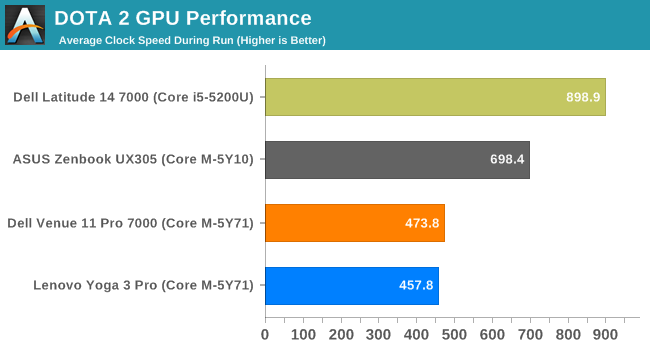
The GPU is really the story though, since this is a gaming workload. Amazingly the ASUS is only 100 MHz off of its maximum turbo frequency as an average for this 45 minute workload. Both the Dell Venue 11 Pro and the Yoga 3 Pro do not have enough cooling to keep these kinds of sustained GPU loads going.
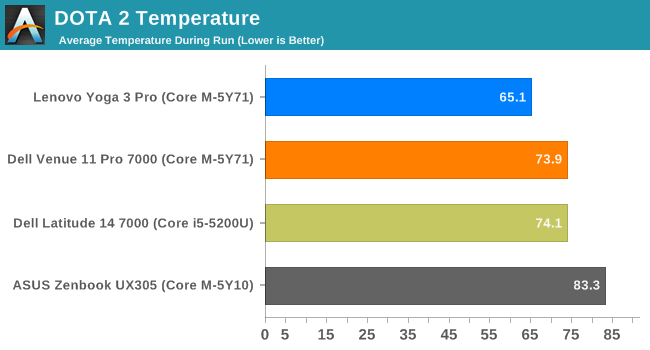
The Yoga 3 Pro is by far the coolest SoC in almost all of these tests, with its combination of active cooling and a 65°C maximum SoC temperature. The ASUS is far and away the hottest device in this test, but it also does a lot more work than the other Core M devices, and it is not getting any hotter by the end of the test, so the device cooling is doing its job.
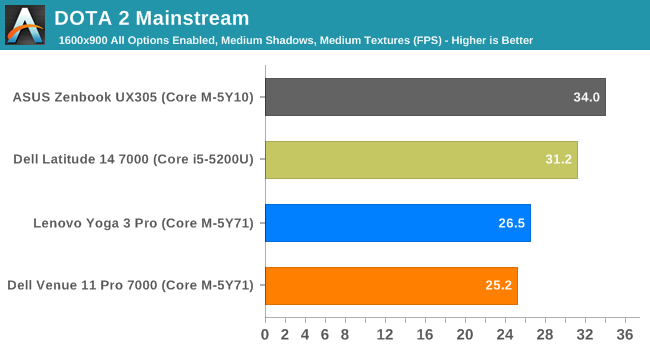
It is clear at this point that the ASUS can keep the GPU frequency much higher than the other Core M devices due to the nature of its cooling, and form factor. The DOTA 2 test is really dominated by it. It is much faster in this test than the other Core M devices, and once again due to the single-channel nature of the Core i5, the ASUS even outperforms the Core i5 in this test.


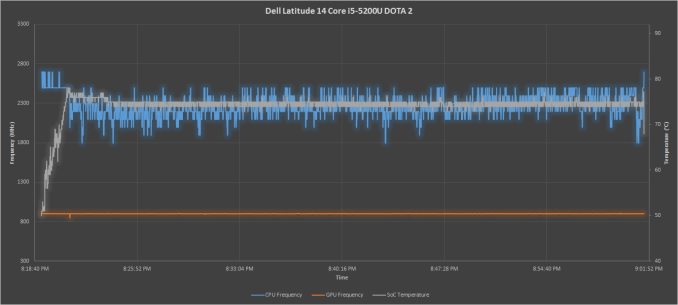
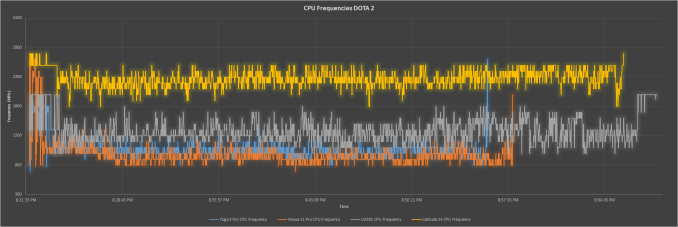
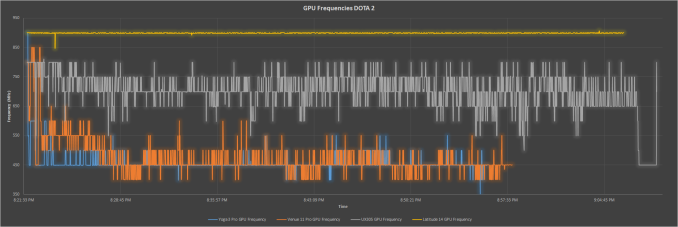
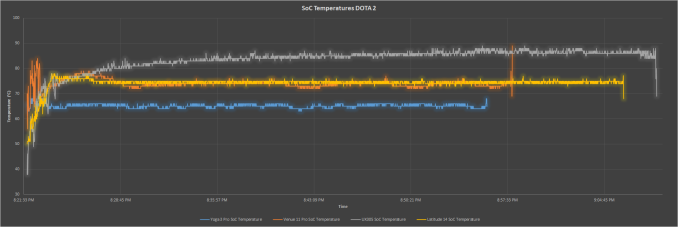








110 Comments
View All Comments
maxxbot - Wednesday, April 8, 2015 - link
If the device buyer's choice is between the Core M and an ARM or Atom they're going to go with the Core M because it's faster in every aspect, especially burst performance. If the Core M in unacceptable slow for you then there aren't any other options at the 4.5W TDP level to turn to, it's the best currently available.name99 - Wednesday, April 8, 2015 - link
That ("Maybe Intel made too many compromises") seems like the wrong lesson.I think a better lesson is that the Clayton Christensen wheel of reincarnation has turned yet again.
There was a time more than 40 years ago when creating a computer was a demanding enough exercise that the only companies that could do it well were integrated top to bottom, forced to do everything from designing the CPU to the OS to the languages that ran on it.
The PC exploded this model as standardized interfaces allowed different vendors to supply the BIOS, the OS, the CPU, the motherboard, the storage, etc.
BUT as we push harder and harder against fundamental physics and what we want the devices to do, the abstractions of these "interfaces" start to impose serious costs. It's no longer good enough to just slap parts together and assume that the whole will work acceptably. We have seen this in mobile, with a gradual thinning out of the field there; but we're poised to see the same thing in PCs (at least in very mobile PCs which, sadly for the OEMs, is the most dynamic part of the business).
This also suggests that Apple's advantage is just going to keep climbing. Even as they use Intel chips like everyone else, they have a lot more control over the whole package, from precisely tweaked OS dynamics to exquisitely machined bodies that are that much more effective in heat dissipation. (And it gets even worse if they decide to switch to their own CPU+GPU SoC for OSX.)
It's interesting, in this context, where the higher frequency 1.2GHz part is difficult for some vendors to handle, to realize that Apple is offering a (Apple-only?) 1.3/2.9GHz option which, presumably, they believe they have embodied in a case that can handle its peak thermals and get useful work out of the extra speed boost.
HakkaH - Friday, April 10, 2015 - link
Device buyers don't even see beyond the price tag, brand name and looks. 90% of the people who buy tech are pretty oblivious on what they are buying. So they wouldn't even know if a device would throttle the speed at all.Secondly I'd rather have a device that throttles good which processors are doing the last couple of years than have a steady pace at which it just crawls along and maybe after 5 minutes decides... hey maybe I can add 200 MHz and still be okay. If that is your case I bet you still have the first generation smartphone in your pocket instead of a more recent model because they all aggressively throttle the CPU and GPU in order to keep you from throwing your phone out of your hands ;)
HP - Saturday, August 8, 2015 - link
Your description doesn't follow the usage paradigm of most computing tasks. As the user is actively using their device what they do on the machine roughly tracks the user's thought patterns which largely takes place in series. He doesn't batch the tasks in his head first and then execute them. So race to sleep is where it's at.milkod2001 - Wednesday, April 8, 2015 - link
What about Intel's native 4 core mobile CPUs. Are any in the works?Core M,Y, U(2 core) etc might be OK for bloggers, content consumers etc but if one wants/needs real performance on the go, there's not that much new to offer, right?
nathanddrews - Wednesday, April 8, 2015 - link
I think we'll have to settle for the i7-4700 until Skylake. Not a bad place to settle.kpkp - Wednesday, April 8, 2015 - link
"Atom competed against high powered ARM SoCs and fit in that mini-PC/tablet to sub 10-inch 2-in-1 area either running Android, Windows RT or the full Windows 8.1 in many of the devices on the market."Atom in Windows RT? Wasn't RT ARM only?
Essence_of_War - Wednesday, April 8, 2015 - link
Very impressed by the Zenbook, especially at its price point.boblozano - Wednesday, April 8, 2015 - link
Thanks for the detailed article.In this space it's clear that the top design consideration is cooling - do that well, and everything else follows. Performance will be delivered by the SoC's ability to turbo as needed, power consumption by the SoC and the rest of the design.
Of course materials, size, the question of passive vs. active cooling ... all that also factors decisively into the success of a design, whether the target market actually buys the devices.
But the effectiveness of the cooling will largely determine performance.
Refuge - Wednesday, April 8, 2015 - link
The efficiency of the cooling too. Can't have it take up too much space or too much power (If active and not passive)otherwise you leave either no room for your battery, or you drain it too fast keeping the thing cool (In the case of active)